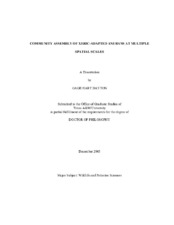| dc.contributor.advisor | Fitzgerald, Lee A. | |
| dc.creator | Dayton, Gage Hart | |
| dc.date.accessioned | 2006-04-12T16:06:00Z | |
| dc.date.available | 2006-04-12T16:06:00Z | |
| dc.date.created | 2005-12 | |
| dc.date.issued | 2006-04-12 | |
| dc.identifier.uri | https://hdl.handle.net/1969.1/3296 | |
| dc.description.abstract | The distribution and abundance of organisms is influenced by historical, abiotic,
and biotic factors. The goal of my dissertation was to determine the distribution of
anurans in the Big Bend region of the Chihuahuan Desert and to examine how abiotic
and biotic factors shape the composition and structure of anuran communities at multiple
spatial scales. My approach relied on extensive field surveys, laboratory and field
experiments, and GIS modeling.
Results from field surveys and reciprocal transplant studies of tadpoles indicate
that abiotic conditions of the breeding site most likely do not play a significant role in
causing the segregation of species among individual breeding pools. I used laboratory
and mesocosm experiments to test for indirect and direct effects of predators on growth
and survival of S. couchii tadpoles. I found that S. couchii tadpoles do not alter their
behavior in the presence of predators and are very susceptible to predation. Although
tadpoles reared with predators suffered high mortality rates, they metamorphosed
significantly faster than tadpoles reared without predators. The reduced time to metamorphose is likely a result of the thinning of intraspecific competitors. Because the
primary cause of death for S. couchii tadpoles is desiccation due to pond drying,
predators may play an important role in facilitating metamorphosis by decreasing
competitors and thus increasing per capita resources, therefore decreasing time to
metamorphosis for the surviving tadpoles.
At the landscape level anuran distributions seem to be influenced by
environmental factors that influence the survival of the adult stage. At the level of the
breeding site, microhabitat and abiotic components of the aquatic environment do not
seem to play an important role in influencing breeding site use by different species.
Rather, it seems likely that predation on tadpoles by predators is important in limiting
the distribution of some species and that the fast-developing S. couchii may exclude
other species from using sites via oophagy and predation on small tadpoles. My
research elucidates the fact that in order to understand factors important in regulating
ecological communities it is important to examine both abiotic and biotic factors at
multiple spatial scales. | en |
| dc.format.extent | 970335 bytes | en |
| dc.format.medium | electronic | en |
| dc.format.mimetype | application/pdf | |
| dc.language.iso | en_US | |
| dc.publisher | Texas A&M University | |
| dc.subject | Anuran | en |
| dc.subject | community ecology | en |
| dc.subject | Scaphiopus | en |
| dc.subject | Bufo | en |
| dc.title | Community assembly of xeric-adapted anurans at multiple spatial scales | en |
| dc.type | Book | en |
| dc.type | Thesis | en |
| thesis.degree.department | Wildlife and Fisheries Sciences | en |
| thesis.degree.discipline | Wildlife and Fisheries Sciences | en |
| thesis.degree.grantor | Texas A&M University | en |
| thesis.degree.name | Doctor of Philosophy | en |
| thesis.degree.level | Doctoral | en |
| dc.contributor.committeeMember | Dixon, James R. | |
| dc.contributor.committeeMember | Lacher, Thomas E. | |
| dc.contributor.committeeMember | Wu, Xinyuan Ben | |
| dc.type.genre | Electronic Dissertation | en |
| dc.type.material | text | en |
| dc.format.digitalOrigin | born digital | en |


